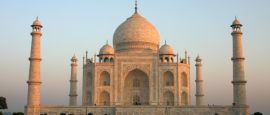India Weather, climate and geography
Weather & climate
The weather is mainly hot most of the year with significant variations from region to region. The coolest weather lasts from around the end ofNovember to the beginning of March, with fresh mornings and evenings, and mostly sunny days. The really hot weather, when it is dry, dusty and unpleasant, is between March and June. Monsoon rains occur in most regions in summer anywhere between June and early October.
Western Himalayas: Srinagar is best from March to October; July to August can be cold and damp in winter. Shimla is higher and therefore colder in winter. Places like Gulmarg, Manali and Pahalgam are usually under several feet of snow from December to March and temperatures in Ladakh, which is a high-altitude desert, can be extremely cold. The mountain passes of Ladakh are accessible from July to October.
Northern Plains: Cities like New Delhi, Varanasi, Lucknow and Patna experience an extreme range of temperatures and are typically warm from April to mid-June, falling to almost freezing at night in winter between November and February. Summers are hot with monsoons between June and September.
Central India: Madhya Pradesh state escapes the very worst of the hot season, but monsoons are heavy between July and September. Temperatures fall at night in winter.
Western India: November to February is most comfortable, although evenings can be fairly cold. Summers can be extremely hot with monsoon rainfall between mid June and mid September.
Eastern India: Weather in states like Orissa (which is flood-prone) are defined by cooler weather from October to February, scorching heat from March to May and unavoidable drenching from the monsoons from June to October.
Southwest: The most pleasant weather is from November to March. Monsoon rains fall anywhere between late April and July. Summer temperatures are not as high as Northern India although humidity is extreme. The coast benefits from some cooling breezes. Inland, Mysore and Bijapur have pleasant climates with relatively low rainfall.
Southeast: Tamil Nadu experiences a northeast monsoon between October and December and temperatures and humidity are high all year. The hills can be cold in winter.
Northeast: March to June and September to November are the driest and most pleasant periods. The rest of the year has extremely heavy monsoon rainfall.
Lightweight, loose-fitting clothes are best along the coast and during the dry season in most of India between March and June. When the heat becomes intolerable, you may sweat a lot and want to change a few times a day.
Layer up if you’re visiting the highlands even in the summer as temperatures can drop significantly at night. Also, wrap up warmly if you’re visiting the northern plains, particularly from November to February.
To avoid offending local sensibilities, female travellers should wear clothes that cover the arms and legs, and pack a cotton scarf to cover your head/neck for extra modesty, especially when visiting temples and holy sites. At tourist seaside resorts such as Goa and Mumbai, female travellers can swim in bikinis but beyond tourist areas, it is best for female tourists to swim in t-shirts and shorts as they can help deflect unwanted attention.
Geography
India shares borders to the northwest with Pakistan, to the north with China, Nepal and Bhutan, and to the east with Bangladesh and Myanmar. To the west lies the Arabian Sea, to the east the Bay of Bengal and to the south the Indian Ocean. The Andaman and Nicobar Islands are Indian territory but lie off the coast of Thailand in the Bay of Bengal. Sri Lanka lies off the southeast coast, and the Maldives off the southwest coast.
The far north-eastern states and territories are all but separated from the rest of India by Bangladesh as it extends northwards from the Bay of Bengal towards Bhutan. India is separated from the rest of Asia by mountain ranges, forest, and desert -the Himalayan mountain range in the north, the Thar Desert in the west and the Chin Hills and Patkai ranges in the east. The Indus River runs through the northern disputed territory of Jammu & Kashmir. The most sacred of rivers, the Ganges, is in the east.
Do you have any Feedback about this page?
© 2025 Columbus Travel Media Ltd. All rights reserved. No part of this site may be reproduced without our written permission, click here for information on Columbus Content Solutions.





 You know where
You know where
